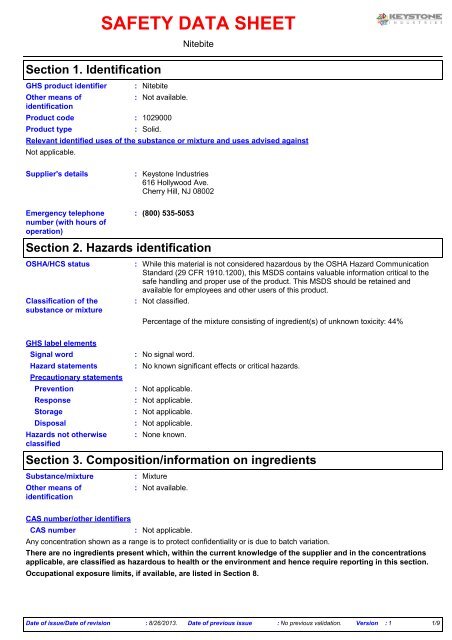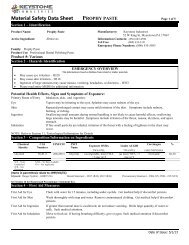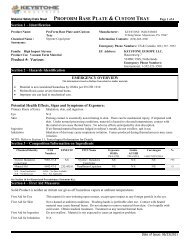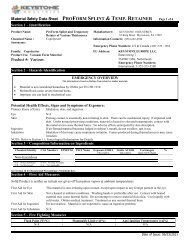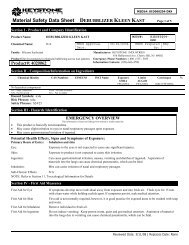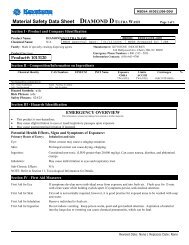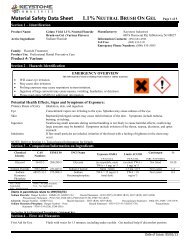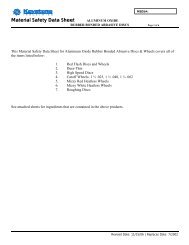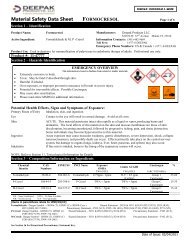MSDS - Keystone Industries
MSDS - Keystone Industries
MSDS - Keystone Industries
Create successful ePaper yourself
Turn your PDF publications into a flip-book with our unique Google optimized e-Paper software.
SAFETY DATA SHEETNitebiteSection 1. IdentificationGHS product identifierOther means ofidentificationProduct type:::NitebiteNot available.Product code : 1029000Solid.Relevant identified uses of the substance or mixture and uses advised againstNot applicable.Supplier's details: <strong>Keystone</strong> <strong>Industries</strong>616 Hollywood Ave.Cherry Hill, NJ 08002Emergency telephonenumber (with hours ofoperation):(800) 535-5053Section 2. Hazards identificationOSHA/HCS statusClassification of thesubstance or mixture: While this material is not considered hazardous by the OSHA Hazard CommunicationStandard (29 CFR 1910.1200), this <strong>MSDS</strong> contains valuable information critical to thesafe handling and proper use of the product. This <strong>MSDS</strong> should be retained andavailable for employees and other users of this product.: Not classified.Percentage of the mixture consisting of ingredient(s) of unknown toxicity: 44%GHS label elementsSignal wordHazard statementsPrecautionary statementsPreventionResponseStorageDisposalHazards not otherwiseclassified: No signal word.: No known significant effects or critical hazards.: Not applicable.: Not applicable.: Not applicable.: Not applicable.: None known.Section 3. Composition/information on ingredientsSubstance/mixtureOther means ofidentification:Mixture: Not available.CAS number/other identifiersCAS number: Not applicable.Any concentration shown as a range is to protect confidentiality or is due to batch variation.There are no ingredients present which, within the current knowledge of the supplier and in the concentrationsapplicable, are classified as hazardous to health or the environment and hence require reporting in this section.Occupational exposure limits, if available, are listed in Section 8.Date of issue/Date of revision : 8/26/2013. Date of previous issue : No previous validation. Version : 1 1/9
NitebiteSection 4. First aid measuresDescription of necessary first aid measuresEye contactInhalationSkin contactIngestion ::::Immediately flush eyes with plenty of water, occasionally lifting the upper and lowereyelids. Check for and remove any contact lenses. Get medical attention if irritationoccurs.Remove victim to fresh air and keep at rest in a position comfortable for breathing. Getmedical attention if symptoms occur.Flush contaminated skin with plenty of water. Remove contaminated clothing andshoes. Get medical attention if symptoms occur.Wash out mouth with water. Remove victim to fresh air and keep at rest in a positioncomfortable for breathing. If material has been swallowed and the exposed person isconscious, give small quantities of water to drink. Do not induce vomiting unlessdirected to do so by medical personnel. Get medical attention if symptoms occur.Most important symptoms/effects, acute and delayedPotential acute health effectsEye contact: No known significant effects or critical hazards.Inhalation: No known significant effects or critical hazards.Skin contact: No known significant effects or critical hazards.Ingestion: No known significant effects or critical hazards.Over-exposure signs/symptomsEye contactInhalationSkin contactIngestion: No specific data.:::No specific data.No specific data.No specific data.Indication of immediate medical attention and special treatment needed, if necessaryNotes to physicianSpecific treatmentsProtection of first-aiders: Treat symptomatically. Contact poison treatment specialist immediately if largequantities have been ingested or inhaled.: No specific treatment.: No action shall be taken involving any personal risk or without suitable training.See toxicological information (Section 11)Section 5. Fire-fighting measuresExtinguishing mediaSuitable extinguishingmediaUnsuitable extinguishingmedia::Use an extinguishing agent suitable for the surrounding fire.None known.Specific hazards arisingfrom the chemicalHazardous thermaldecomposition products::No specific fire or explosion hazard.Decomposition products may include the following materials:carbon dioxidecarbon monoxidehalogenated compoundsSpecial protective actionsfor fire-fightersSpecial protectiveequipment for fire-fighters::Promptly isolate the scene by removing all persons from the vicinity of the incident ifthere is a fire. No action shall be taken involving any personal risk or without suitabletraining.Fire-fighters should wear appropriate protective equipment and self-contained breathingapparatus (SCBA) with a full face-piece operated in positive pressure mode.Date of issue/Date of revision : 8/26/2013. Date of previous issue : No previous validation. Version : 1 2/9
NitebiteSection 6. Accidental release measuresPersonal precautions, protective equipment and emergency proceduresFor non-emergencypersonnelFor emergency responders: No action shall be taken involving any personal risk or without suitable training.Evacuate surrounding areas. Keep unnecessary and unprotected personnel fromentering. Do not touch or walk through spilled material. Put on appropriate personalprotective equipment.: If specialised clothing is required to deal with the spillage, take note of any informationin Section 8 on suitable and unsuitable materials. See also the information in "For nonemergencypersonnel".Environmental precautions:Avoid dispersal of spilled material and runoff and contact with soil, waterways, drainsand sewers. Inform the relevant authorities if the product has caused environmentalpollution (sewers, waterways, soil or air).Methods and materials for containment and cleaning upSmall spill :Large spill :Section 7. Handling and storagePrecautions for safe handlingAdvice on generaloccupational hygieneMove containers from spill area. Vacuum or sweep up material and place in adesignated, labeled waste container. Dispose of via a licensed waste disposalcontractor.Move containers from spill area. Prevent entry into sewers, water courses, basementsor confined areas. Vacuum or sweep up material and place in a designated, labeledwaste container. Dispose of via a licensed waste disposal contractor. Note: seeSection 1 for emergency contact information and Section 13 for waste disposal.Protective measures : Put on appropriate personal protective equipment (see Section 8).:Eating, drinking and smoking should be prohibited in areas where this material ishandled, stored and processed. Workers should wash hands and face before eating,drinking and smoking. Remove contaminated clothing and protective equipment beforeentering eating areas. See also Section 8 for additional information on hygienemeasures.Conditions for safe storage,including anyincompatibilitiesNone.:Store in accordance with local regulations. Store in original container protected fromdirect sunlight in a dry, cool and well-ventilated area, away from incompatible materials(see Section 10) and food and drink. Keep container tightly closed and sealed untilready for use. Containers that have been opened must be carefully resealed and keptupright to prevent leakage. Do not store in unlabeled containers. Use appropriatecontainment to avoid environmental contamination.Section 8. Exposure controls/personal protectionControl parametersOccupational exposure limitsAppropriate engineeringcontrolsEnvironmental exposurecontrols: Good general ventilation should be sufficient to control worker exposure to airbornecontaminants.: Emissions from ventilation or work process equipment should be checked to ensurethey comply with the requirements of environmental protection legislation. In somecases, fume scrubbers, filters or engineering modifications to the process equipmentwill be necessary to reduce emissions to acceptable levels.Individual protection measuresHygiene measures :Wash hands, forearms and face thoroughly after handling chemical products, beforeeating, smoking and using the lavatory and at the end of the working period.Appropriate techniques should be used to remove potentially contaminated clothing.Wash contaminated clothing before reusing. Ensure that eyewash stations and safetyshowers are close to the workstation location.Date of issue/Date of revision : 8/26/2013. Date of previous issue : No previous validation. Version : 1 3/9
NitebiteSection 8. Exposure controls/personal protectionEye/face protectionSkin protection:Safety eyewear complying with an approved standard should be used when a riskassessment indicates this is necessary to avoid exposure to liquid splashes, mists,gases or dusts. If contact is possible, the following protection should be worn, unlessthe assessment indicates a higher degree of protection: safety glasses with sideshields.Hand protection : Chemical-resistant, impervious gloves complying with an approved standard should beworn at all times when handling chemical products if a risk assessment indicates this isnecessary.Body protection : Personal protective equipment for the body should be selected based on the task beingperformed and the risks involved and should be approved by a specialist beforehandling this product.Other skin protection : Appropriate footwear and any additional skin protection measures should be selectedbased on the task being performed and the risks involved and should be approved by aspecialist before handling this product.Respiratory protection : Use a properly fitted, particulate filter respirator complying with an approved standard ifa risk assessment indicates this is necessary. Respirator selection must be based onknown or anticipated exposure levels, the hazards of the product and the safe workinglimits of the selected respirator.Section 9. Physical and chemical propertiesAppearancePhysical stateColorOdorOdor thresholdpHMelting pointBoiling pointFlash pointBurning timeBurning rateEvaporation rateFlammability (solid, gas)Lower and upper explosive(flammable) limitsVapor pressureVapor densityRelative densitySolubilitySolubility in waterPartition coefficient: n-octanol/waterAuto-ignition temperatureDecomposition temperatureSADTViscosity: Solid.: Various: Not available.: Not available.: Not available.: Not available.: Not available.: Not available.: Not available.: Not available.: Not available.: Not available.: Not available.: Not available.: Not available.: Not available.: Not available.: Not available.: Not available.: Not available.: Not available.: Not available.: Not available.Date of issue/Date of revision : 8/26/2013. Date of previous issue : No previous validation. Version : 1 4/9
NitebiteSection 10. Stability and reactivityReactivity: No specific test data related to reactivity available for this product or its ingredients.Chemical stability:The product is stable.Possibility of hazardousreactions: Under normal conditions of storage and use, hazardous reactions will not occur.Conditions to avoid:No specific data.Incompatible materials :No specific data.Hazardous decompositionproducts:Under normal conditions of storage and use, hazardous decomposition products shouldnot be produced.Section 11. Toxicological informationInformation on toxicological effectsAcute toxicityNot available.Irritation/CorrosionNot available.SensitizationNot available.MutagenicityNot available.CarcinogenicityNot available.Reproductive toxicityNot available.TeratogenicityNot available.Specific target organ toxicity (single exposure)Not available.Specific target organ toxicity (repeated exposure)Not available.Aspiration hazardNot available.Information on the likelyroutes of exposurePotential acute health effectsEye contactInhalationSkin contactIngestion: Not available.: No known significant effects or critical hazards.: No known significant effects or critical hazards.: No known significant effects or critical hazards.: No known significant effects or critical hazards.Symptoms related to the physical, chemical and toxicological characteristicsEye contact: No specific data.Date of issue/Date of revision : 8/26/2013. Date of previous issue : No previous validation. Version : 1 5/9
NitebiteSection 11. Toxicological informationInhalationSkin contactIngestion:::No specific data.No specific data.No specific data.Delayed and immediate effects and also chronic effects from short and long term exposureShort term exposurePotential immediateeffectsPotential delayed effectsLong term exposurePotential immediateeffectsPotential delayed effectsPotential chronic health effectsNot available.General :Carcinogenicity :Mutagenicity :Teratogenicity :Developmental effectsFertility effects: Not available.: Not available.: Not available.: Not available.No known significant effects or critical hazards.No known significant effects or critical hazards.No known significant effects or critical hazards.No known significant effects or critical hazards.: No known significant effects or critical hazards.: No known significant effects or critical hazards.Numerical measures of toxicityAcute toxicity estimatesNot available.Section 12. Ecological informationToxicityNot available.Persistence and degradabilityBioaccumulative potentialNot available.Mobility in soilSoil/water partitioncoefficient (KOC): Not available.Other adverse effects: No known significant effects or critical hazards.Section 13. Disposal considerationsDisposal methods:The generation of waste should be avoided or minimized wherever possible. Disposalof this product, solutions and any by-products should at all times comply with therequirements of environmental protection and waste disposal legislation and anyregional local authority requirements. Dispose of surplus and non-recyclable productsvia a licensed waste disposal contractor. Waste should not be disposed of untreated tothe sewer unless fully compliant with the requirements of all authorities with jurisdiction.Waste packaging should be recycled. Incineration or landfill should only be consideredDate of issue/Date of revision : 8/26/2013. Date of previous issue : No previous validation. Version : 1 6/9
NitebiteSection 13. Disposal considerationsSection 14. Transport informationwhen recycling is not feasible. This material and its container must be disposed of in asafe way. Empty containers or liners may retain some product residues. Avoiddispersal of spilled material and runoff and contact with soil, waterways, drains andsewers.DOTClassificationTDGClassificationMexicoClassificationADR/RIDIMDGIATAUN numberNot available.Not available.Not available.Not available.Not available.Not available.UN propershipping nameNot available.Not available.Not available.Not available.Not available.Not available.Transporthazard class(es)Not available.Not available.Not available.Not available.Not available.Not available.Packing group------EnvironmentalhazardsAdditionalinformationNo. No.No.No.No. No.- ---- -Special precautions for user:Transport within user’s premises: always transport in closed containers that areupright and secure. Ensure that persons transporting the product know what to do in theevent of an accident or spillage.Transport in bulk accordingto Annex II of MARPOL73/78 and the IBC Code: Not available.Section 15. Regulatory informationU.S. Federal regulations :TSCA 8(a) CDR Exempt/Partial exemption: All components are listed or exempted.United States inventory (TSCA 8b): All components are listed or exempted.Clean Air Act Section 112(b) Hazardous AirPollutants (HAPs)Clean Air Act Section 602Class I SubstancesClean Air Act Section 602Class II SubstancesDEA List I Chemicals(Precursor Chemicals)DEA List II Chemicals(Essential Chemicals)SARA 302/304: Not listed: Not listed: Not listed: Not listed: Not listedComposition/information on ingredientsNo products were found.SARA 304 RQSARA 311/312Classification: Not applicable.: Not applicable.Date of issue/Date of revision : 8/26/2013. Date of previous issue : No previous validation. Version : 1 7/9
NitebiteSection 15. Regulatory informationComposition/information on ingredientsNo products were found.State regulationsMassachusetts :New YorkNew JerseyPennsylvaniaCanada inventoryInternational regulationsInternational lists :Chemical WeaponsConvention List ScheduleI ChemicalsChemical WeaponsConvention List ScheduleII ChemicalsChemical WeaponsConvention List ScheduleIII ChemicalsNone of the components are listed.: None of the components are listed.: None of the components are listed.: None of the components are listed.: All components are listed or exempted.Australia inventory (AICS): All components are listed or exempted.China inventory (IECSC): All components are listed or exempted.Japan inventory: All components are listed or exempted.Korea inventory: All components are listed or exempted.Malaysia Inventory (EHS Register): Not determined.New Zealand Inventory of Chemicals (NZIoC): All components are listed or exempted.Philippines inventory (PICCS): All components are listed or exempted.Taiwan inventory (CSNN): Not determined.: Not listed: Not listed: Not listedSection 16. Other informationHazardous Material Information System (U.S.A.)HealthFlammabilityPhysical hazardsPersonal protectionNational Fire Protection Association (U.S.A.)000Caution: HMIS® ratings are based on a 0-4 rating scale, with 0 representing minimal hazards or risks, and 4representing significant hazards or risks Although HMIS® ratings are not required on SDSs under 29 CFR 1910.1200, the preparer may choose to provide them. HMIS® ratings are to be used with a fully implemented HMIS®program. HMIS® is a registered mark of the National Paint & Coatings Association (NPCA). HMIS® materialsmay be purchased exclusively from J. J. Keller (800) 327-6868.The customer is responsible for determining the PPE code for this material.Health000FlammabilityInstability/ReactivitySpecialReprinted with permission from NFPA 704-2001, Identification of the Hazards of Materials for EmergencyResponse Copyright ©1997, National Fire Protection Association, Quincy, MA 02269. This reprinted material isnot the complete and official position of the National Fire Protection Association, on the referenced subjectwhich is represented only by the standard in its entirety.Date of issue/Date of revision : 8/26/2013. Date of previous issue : No previous validation. Version : 1 8/9
NitebiteSection 16. Other informationCopyright ©2001, National Fire Protection Association, Quincy, MA 02269. This warning system is intended tobe interpreted and applied only by properly trained individuals to identify fire, health and reactivity hazards ofchemicals. The user is referred to certain limited number of chemicals with recommended classifications inNFPA 49 and NFPA 325, which would be used as a guideline only. Whether the chemicals are classified by NFPAor not, anyone using the 704 systems to classify chemicals does so at their own risk.HistoryDate of printingDate of issue/Date ofrevisionDate of previous issueVersionKey to abbreviationsReferencesNotice to reader::::8/26/2013.8/26/2013.No previous validation.1: ATE = Acute Toxicity EstimateBCF = Bioconcentration FactorGHS = Globally Harmonized System of Classification and Labelling of ChemicalsIATA = International Air Transport AssociationIBC = Intermediate Bulk ContainerIMDG = International Maritime Dangerous GoodsLogPow = logarithm of the octanol/water partition coefficientMARPOL 73/78 = International Convention for the Prevention of Pollution From Ships,1973 as modified by the Protocol of 1978. ("Marpol" = marine pollution)UN = United Nations: Not available.Indicates information that has changed from previously issued version.To the best of our knowledge, the information contained herein is accurate. However, neither the above-namedsupplier, nor any of its subsidiaries, assumes any liability whatsoever for the accuracy or completeness of theinformation contained herein.Final determination of suitability of any material is the sole responsibility of the user. All materials may presentunknown hazards and should be used with caution. Although certain hazards are described herein, we cannotguarantee that these are the only hazards that exist.Date of issue/Date of revision : 8/26/2013. Date of previous issue : No previous validation. Version : 1 9/9


